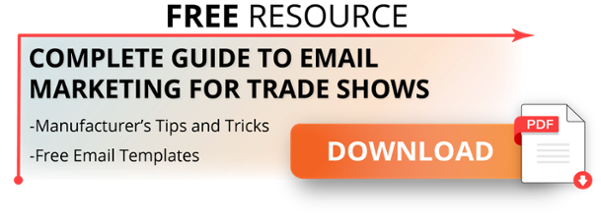Inbound Marketing Blog
for Manufacturers and Healthcare Companies
How to Handle Healthcare Technology Trade Show Marketing in 2021

It’s no secret that B2B trade shows are going to look much different in 2021. Is your business ready to make the necessary changes to the way you market at trade shows -- even if you’re not really there?
According to the Center for Exhibition Research, there were approximately 9,400 B2B trade shows and exhibitions held in the U.S. in 2019, contributing $101 billion to the nation’s GDP. At these events, companies are able to showcase their newest products and services, salespeople network and build new connections, while also having the opportunity to speak with old ones, and customers can shop and meet with sales representatives. These trade shows brought about opportunities for businesses in an industry where word-of-mouth is critical.
In early 2020, life as we knew it changed. The rise of COVID-19 throughout the world shifted the way business -- and trade shows -- were conducted. Live events were cancelled or moved to virtual setups. The pandemic caused the need for drastic reformation for many companies -- but less so for those already engaging in best practices before, during, and after trade shows.
With 2020 coming to a close, what does the new year mean for healthcare technology trade show marketing? Well, no one really knows when life will return to “normal.” It’s safe to say we won’t be seeing the hustle and bustle of crowded trade show floors for quite some time. Some shows may permanently offer remote attendance.
But that doesn’t mean that trade shows can’t happen at all -- it just means your strategy needs to look a little different.
Virtual Is Better … For Now
Despite social distancing procedures and mask-wearing, in-person trade shows may be few and far between until 2022. As a result, trade shows will need to make the jump to virtual, if they didn’t already in 2020. This will be a challenge, but it’s do-able.
Businesses and employees have been adapting to a new wave of business for quite some time. With Zoom, Microsoft Teams, and virtual meetings becoming a huge part of remote business communications, the trade show industry is going to have to make similar changes.
No one is expecting companies to know exactly how to conduct a virtual event of this scale on their own. There are companies that can assist with the execution of these events, ensuring that businesses are able to succeed.
Intrado is one of these companies. The statement below can be found in the company’s virtual event product sheet.
“Are you looking to extend the life of your physical event by hosting it virtually? Perhaps you want to host a sales kickoff meeting for your organization or develop a virtual program designed to launch a new product to the market. The truth is, there are many use cases out there but finding the right solution isn’t easy. Intrado’s Virtual Events offer a consultative approach to determine your use case and provide a solution that makes sense for your company.”
The goal is to determine the pain points of their clients in relation to virtual events and ineffective communication platforms and combat them. These identified pain points include:
- Poor audience retention
- Slow time to market
- Inconsistent messaging
- Incremental revenue growth
- Inability to measure impact
- Rising costs in travel and accessibility to key stakeholders
- Lack of engagement
Intrado believes, “One of the benefits of virtual trade shows is that it allows attendees to control the conversation and ask questions, increasing their ability to get the information they want.” At the end of the day, the goal is to drive traffic. The more engaged attendees, the better. These attendees should be encouraged to engage in the conversations, post to social media with the shared hashtags, and visit specific booths.
Additionally, protecting the attendee experience is crucial. With the nature of virtual events, customer service will be as important as ever.
(Related Article: How to Transition from Trade Shows to Digital Marketing)
Tips for Sales Professionals and Trade Show Attendees Before, During & After
What’s the point in going to a trade show if you get nothing from it? Virtual trade shows are already going to be more difficult than in-person trade shows, so why make it harder? Here are 4 tips for sales professionals at virtual trade shows:
- Pre-book Meetings with Leads
- Research and Prepare
- Social Media -- Use It to Your Advantage!
- Follow Up!
1. Pre-book Meetings with Leads
Pre-booking meetings with leads before you even attend the trade show will greatly benefit your ability to have meaningful sales conversations. With the nature of virtual trade shows, it’s going to be more challenging to make connections with other attendees. It’s easy to get lost in the sea of Zoom windows, so pre-booking meetings would give you a head start and guarantee time with potential leads.
This is where email marketing can play a huge role in your success. Announcing your participating at the show and encouraging meet-ups in your emails to potential leads and customers will benefit you and spread the word.
Make sure you’re coordinating meetings that will be convenient for you and your lead. Referencing the trade show agenda will help guarantee you don’t overbook yourself or your lead. Additionally, you could promote your meeting sign-up link on social media and add it to your email signature.
2. Research and Prepare
Like any meeting or event, researching and preparing is crucial.
Researching your leads or booths you plan on attending, and finding common ground, will jump-start conversations and build relationships. Make your interaction memorable. Doing the research will also help you to identify promising leads who would be beneficial to meet with.
3. Social Media -- Use It to Your Advantage!
Securing meetings with potential leads and customers is never a guarantee. Why not explore every avenue possible?
Again, sharing a link to sign up for a 1-on-1 meeting can help spread the word that you’re looking to connect.
As a sales professional or an attendee, you can also use social media after the trade show to reach out to leads or companies you didn’t get to meet. For example, you could send a message on LinkedIn saying, “Sorry we didn’t get a chance to talk at (insert trade show name). Let’s set up a time to talk in the near future.”
4. Follow Up!
Following up with leads and contacts after the trade show is one of the most important steps you can take as a sales professional or attendee. Sending a follow-up email lets the person know you enjoyed your conversation, appreciated their time, and would like to keep in contact. It also reminds who you are, and helps them remember you among the dozens of other folks they met during the show.
Here are some follow-up trade show email marketing best practices:
- The Simple Reminder: Reach out to the contact and remind them of who you are, and what your company does.
- The Request for Chat: Let the contact know where and how they can reach out to you if they want more information.
- The Resource Send: If your team does not have time at the show to send out helpful resources, it’s never too late. Send them along after the show.
- The Pain Point Soothe: If the contact was talking about something their company struggles with, let them know how they can fix it.
- The Reminder: Did your company offer trade show-specific deals? Remind them to take advantage before time runs out.
(Related Article: Trade Show Email Marketing Best Practices)
2021: A New Wave of Healthcare Technology Trade Show Marketing
2021 is going to look different for everyone -- what works for the hospitality and retail industries may not work for medical tech. However, no matter your industry, there are ways to adapt and adjust.
Attendee experience is everything. Nobody knows when life will return to normal, so ensuring your customers have a good experience at your booth -- or that your salespeople attending as visitors get the most out of their experience -- is paramount.
Our Blogs, Direct to Your Inbox!
How to Audit your Online Marketing
If you are executing digital marketing, congratulations! You are most likely already one step ahead of your competition, and making strides to meaningfully connect with prospects online. But, how do you know if you’re seeing continual success year over year, and improving your metrics?
Without the tools in place to analyze and benchmark your efforts, it is impossible to scale your online marketing and ensure continuous success.


